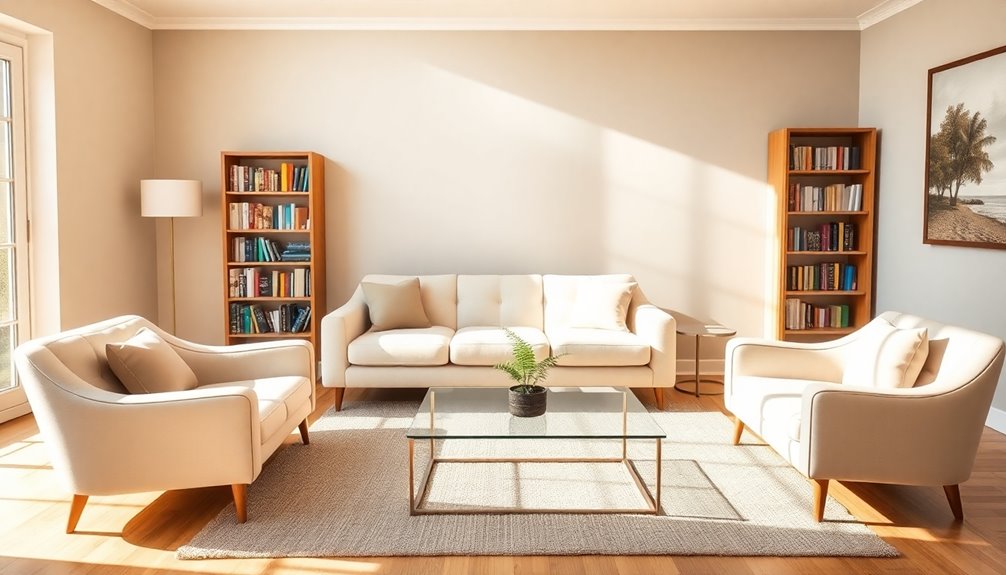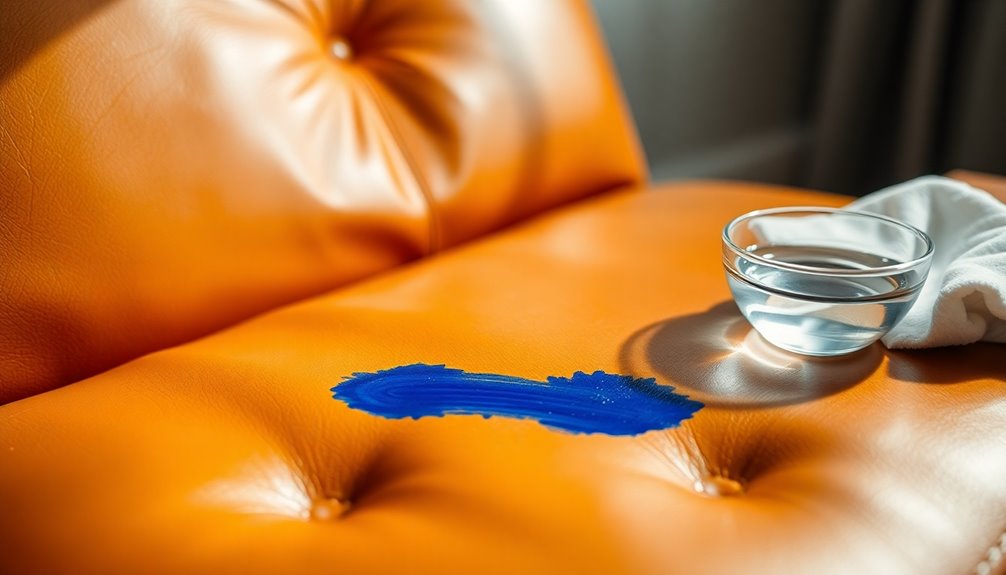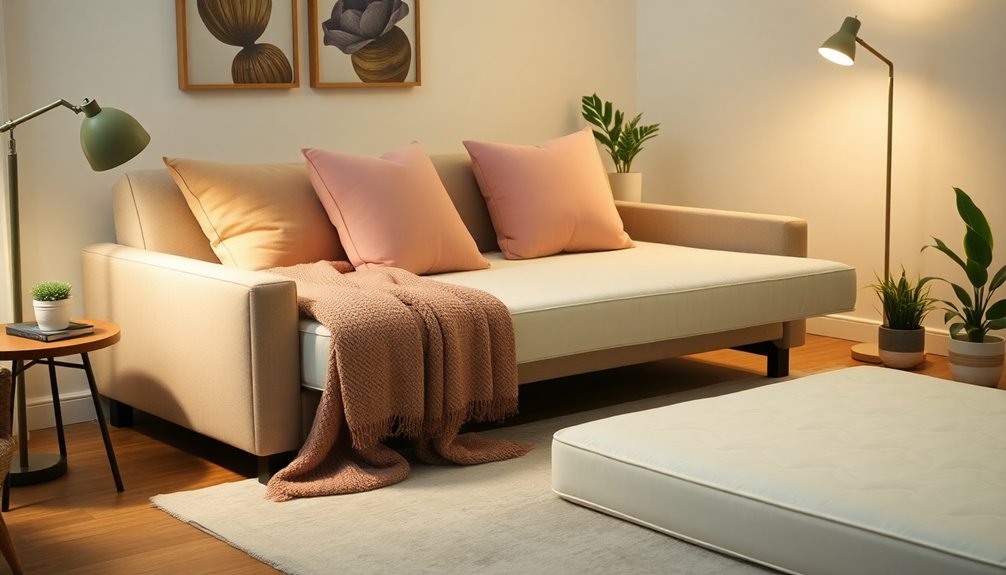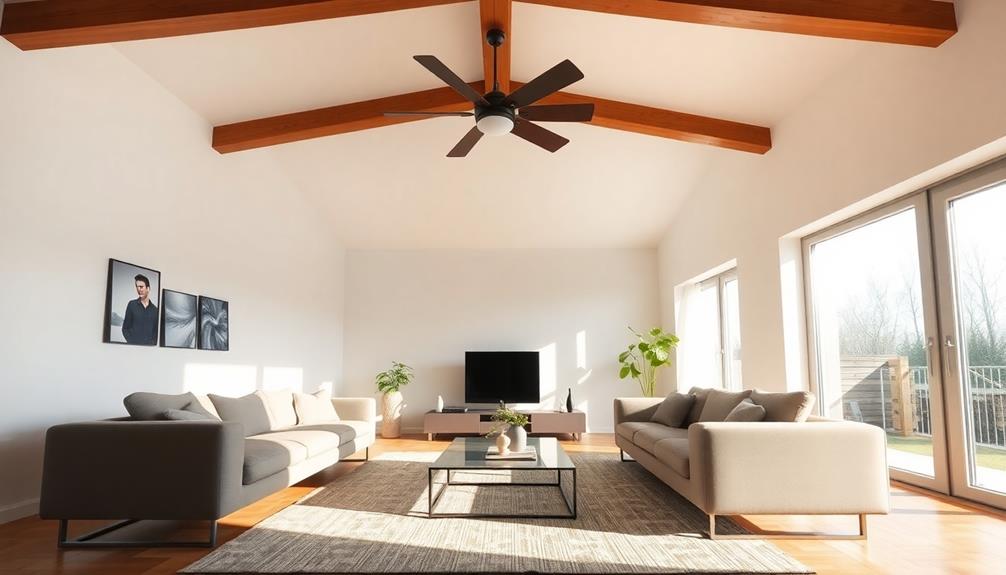To arrange furniture effectively, start by measuring your room and furniture to ensure a good fit. Pick a focal point, like a fireplace or artwork, and measure distances to maintain open pathways. Group furniture for conversation and activity zones, keeping seating within 8 feet of each other. Strive for visual balance with varying heights and textures, and avoid overcrowding by leaving some negative space. Don't hesitate to try different layouts until you find one that feels right. As you explore these tips, you might uncover even more ideas to elevate your space's design.
Key Takeaways
- Measure room dimensions and furniture to create a scaled floor plan for effective layout planning.
- Identify focal points and define functional zones to enhance the room's purpose and visual appeal.
- Ensure clear traffic flow by maintaining at least 30" clearance around furniture and avoiding overcrowding.
- Arrange seating within 8 feet of each other to promote interaction and create a conversational area.
- Consider hiring a professional designer for personalized assistance and cohesive space planning solutions.
Take Measurements and Plan
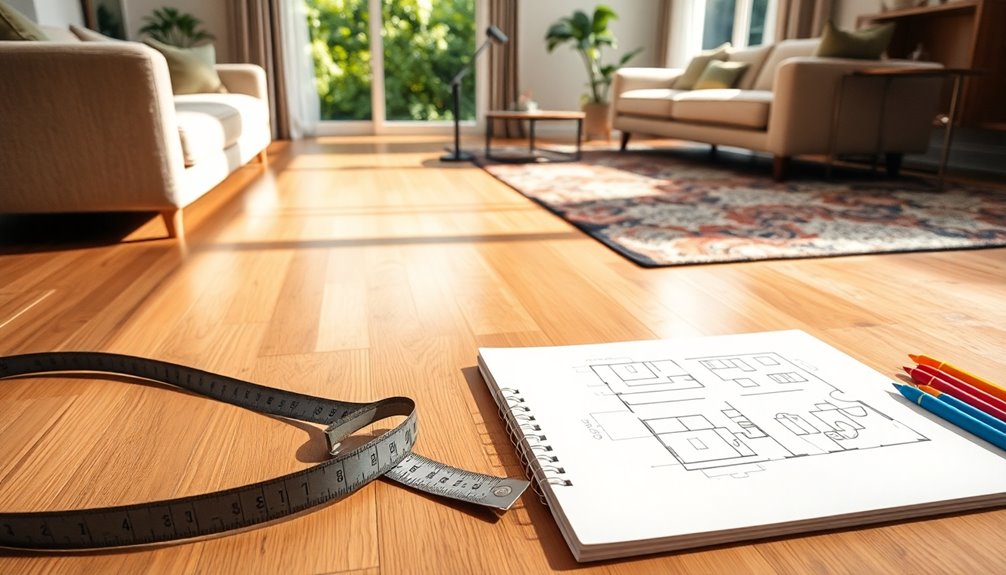
Before you start arranging your furniture, it's crucial to take accurate measurements of both the room and the furniture itself. Measure the length, width, and any irregularities of your space to get a clear understanding of what you're working with. Don't forget to record the core dimensions of your furniture—width, depth, and height—so you know how each piece will fit.
For larger items like sofas or recliners, consider their diagonal depth as well. This ensures they'll pass through doorways and hallways without a hitch. Use these measurements to avoid overcrowding and maintain a good flow within the room.
Next, create a floor plan using your measurements. You can draw a layout on graph paper or use online tools. Cutting out paper representations of your furniture can help you visualize different arrangements. Make sure to maintain 30"-36" of space between major pieces and 16"-18" between your coffee table and seating. This planning helps facilitate comfortable movement and conversations, making your space functional and inviting. Attention to detail is essential in ensuring that each piece serves its intended purpose without hindering movement. Avoid common pitfalls by ensuring you've got all the relevant dimensions before purchasing any new furniture.
Pick a Focal Point
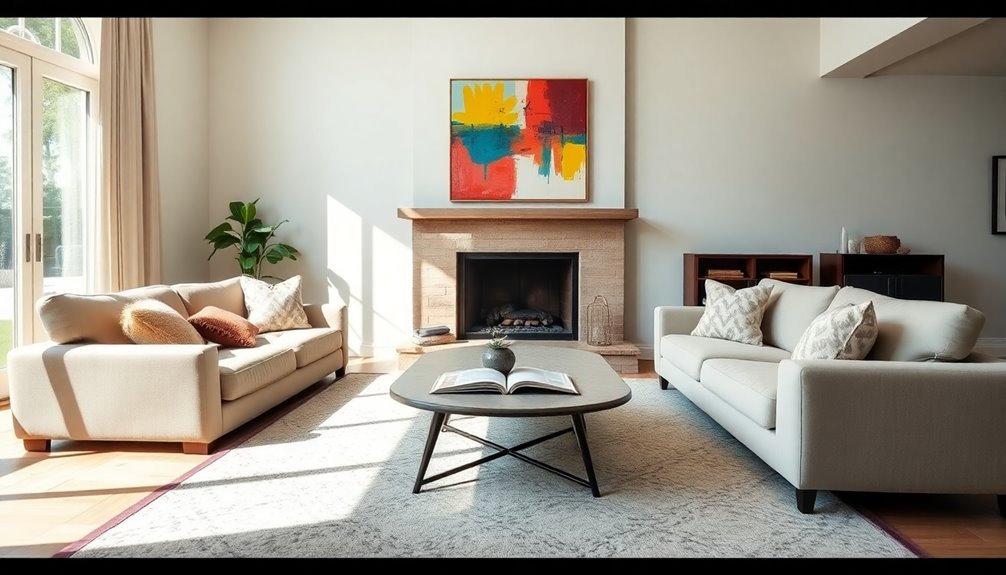
A well-chosen focal point can transform a room, drawing attention and creating a sense of harmony. To identify the right focal point, look for elements like a fireplace, large artwork, or stunning views through windows. Architectural features, such as unique ceiling designs or accent walls, can also serve this purpose. Once you've chosen your focal point, arrange your furniture around it.
Start by positioning your largest pieces, like sofas or chairs, to face the focal point, framing it beautifully. Smaller items, like side tables or accent chairs, should complement the arrangement without obstructing pathways or drawer openings. Group similar furniture pieces together to enhance the overall look. Proper orientation and color palette should be considered to create harmony with the focal point. Additionally, ensure that your furniture arrangement allows for easy financial awareness by enabling smooth flow and conversation. To elevate the comfort and aesthetic appeal of your seating area, pay attention to the finer details, such as arranging sofa pillows effectively. This not only adds color and texture but also enhances the overall comfort, making the space inviting. Don’t forget to layer different sizes and shapes of pillows to create depth, while ensuring that each piece serves both a functional and decorative purpose within the room.
Don't forget to enhance your focal point with décor. Use built-ins around a fireplace or style decor that highlights a piece of artwork. Lighting plays a crucial role too; consider using picture lights or chandeliers to draw attention. Remember, the goal is to create a cohesive look that emphasizes your focal point without overwhelming the space. By thoughtfully choosing and arranging around your focal point, you'll achieve a balanced and inviting atmosphere.
Consider Traffic Flow
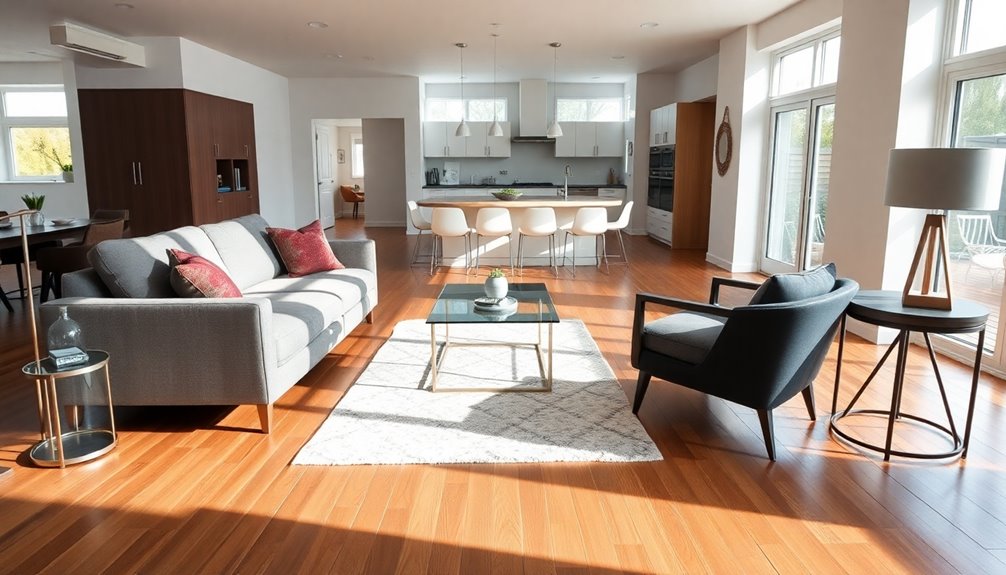
Traffic flow is crucial for creating a comfortable living space. Start by analyzing traffic patterns in your room. Identify natural walking paths and draw lines on a floor plan to visualize these routes. Pay attention to entry and exit points to prevent bottlenecks, and observe focal points to ensure they don't disrupt the flow. Envision daily scenarios to understand how people will move between different areas.
Next, define clear pathways. Keep routes wide enough for foot traffic and ensure furniture guides movement without obstacles. Aim for at least 90 cm of clearance for comfortable circulation, especially for those with mobility challenges. Avoid overcrowding by resisting the urge to fill every corner with furniture. Instead, consider central placements to enhance openness.
Segment the space into functional zones. Create separate areas for seating, circulation, and other activities, ensuring each zone has enough space without encroaching on traffic paths. Use furniture strategically to separate zones while maintaining symmetry. Choose pieces that fit the space and purpose, and avoid placing large items near doors. By adapting your furniture placement to accommodate natural traffic patterns, you'll foster a harmonious and functional living environment. Additionally, ensure that standard clearances are maintained to enhance movement and comfort throughout the space.
Create Conversation Areas
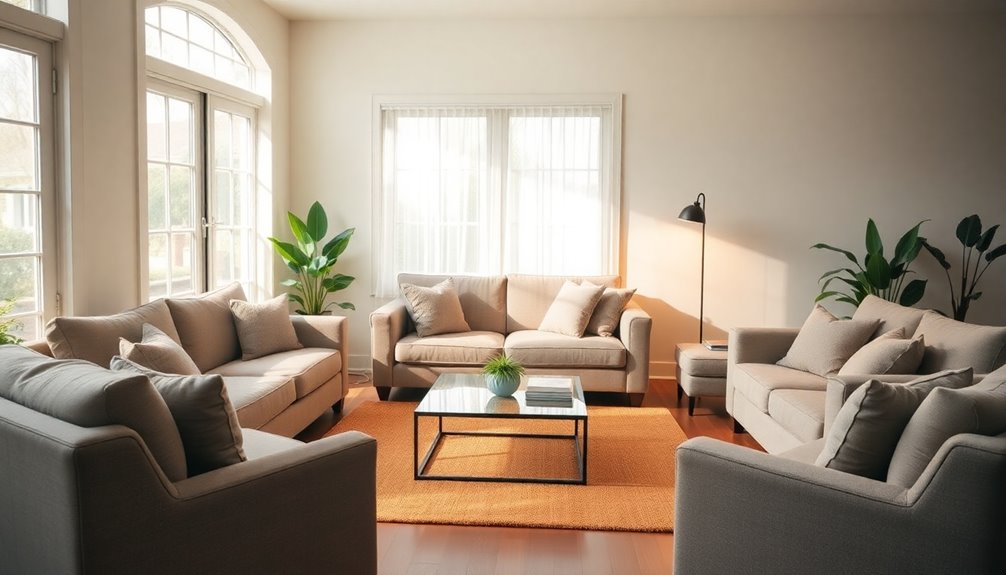
Creating conversation areas is essential for fostering connections and comfort in your living space. Start by identifying the main pathway in your living room to avoid placing the conversation zone directly in its path. Use an area rug to frame the space, helping to define the area visually. Group your furniture, like sofas and chairs, to create a cohesive layout that encourages interaction.
Keep furniture accessible, allowing enough space to move around easily. Position seating so that heads are no more than 8 feet apart, facilitating easy conversation without twisting or turning. Consider using movable pieces like small chairs or ottomans for versatile arrangements. Arrange sofas and chairs to face each other, promoting face-to-face interaction. Avoid pushing furniture against walls in larger rooms, as this can lead to shouting.
Creating a conversation area should ideally measure 7 to 10 feet in diameter for optimal interaction. Create a focal point around which your conversation area revolves, such as a coffee table or fireplace. Use shapes like circular or L-shaped arrangements to invite intimacy. Finally, select comfortable furniture with plush cushions and supportive backs, and choose warm colors to encourage a welcoming atmosphere. By focusing on these elements, you'll create engaging conversation areas that enhance your living space.
Achieve Visual Balance
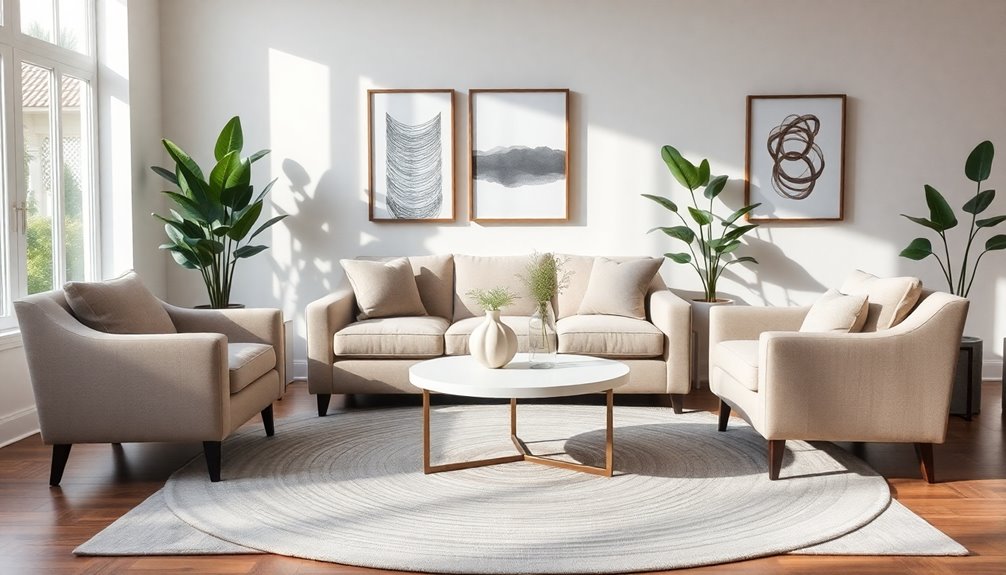
Achieving visual balance in your room can transform the space from chaotic to harmonious. Start by identifying your focal point, whether it's a fireplace, a large window, or an entertainment center. Arrange your furniture around this central element to create either symmetrical or asymmetrical balance. Symmetrical balance uses identical items flanking the focal point, while asymmetrical balance involves different objects that still create a sense of equilibrium.
Consider visual weight when selecting furniture. Vary heights, textures, and colors throughout the space to keep it interesting. For example, combine tall bookshelves with lower seating to break up the lines. Additionally, don't forget about negative space; leaving areas free of clutter allows the eye to rest and enhances overall balance. Incorporating different types of balance in your arrangement can provide distinct visual impacts and styles that enhance the room's aesthetic.
Plan your layout thoughtfully. Use a sketch or digital tool to visualize how everything fits together. Ensure clear pathways for traffic flow, preventing obstructions that could disrupt movement. Remember, functionality is key—arrange items so they serve a purpose, like placing lamps near seating areas. By being mindful of these elements, you'll create a room that feels cohesive and inviting.
Experiment With Layouts
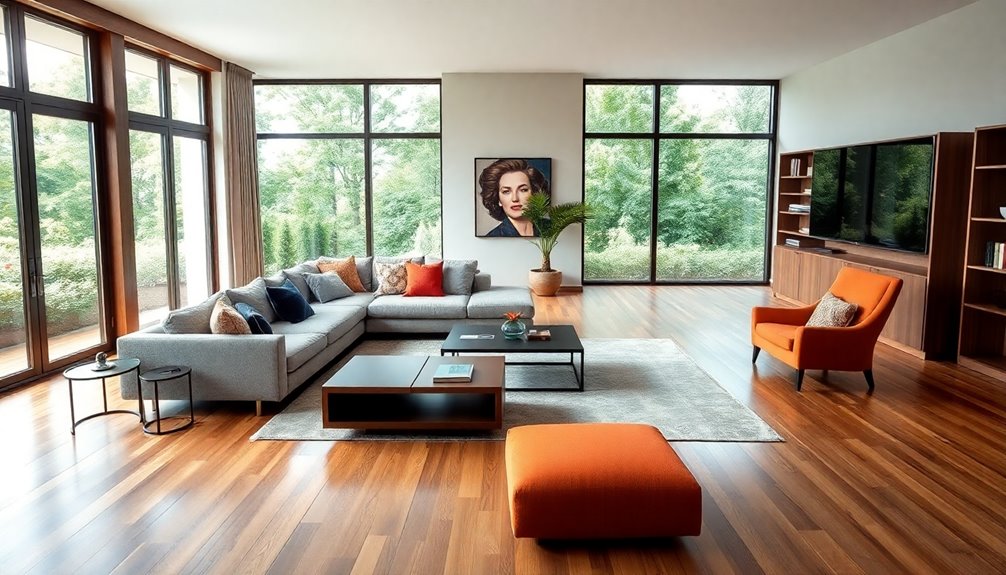
When you experiment with layouts, you'll discover how different arrangements can dramatically change the feel of your space. Start by measuring your room accurately. Use graph paper to create a scaled-down version of your floor plan, noting the positions and widths of doors and obstacles. Record the measurements of your furniture and convert them into a consistent scale for easier planning.
Next, cut out scaled paper or cardboard models of your furniture pieces. This hands-on approach lets you try various layouts directly on your scaled floor plan. Label each model for easy identification. Remember to consider the height and depth of each piece as you arrange them.
Designate different zones for activities like lounging, reading, or socializing. Group similar furniture pieces together to create a cohesive look, using rugs to define these areas. As you test layouts, pay attention to traffic flow and focal points. Incorporating furniture grouping can enhance the functionality and aesthetic appeal of your space. Take photos or make notes to compare different arrangements. Don't hesitate to try unconventional setups; you might stumble upon an arrangement that perfectly suits your needs. Keep refining until you achieve the ideal layout for your space.
Seek Professional Help
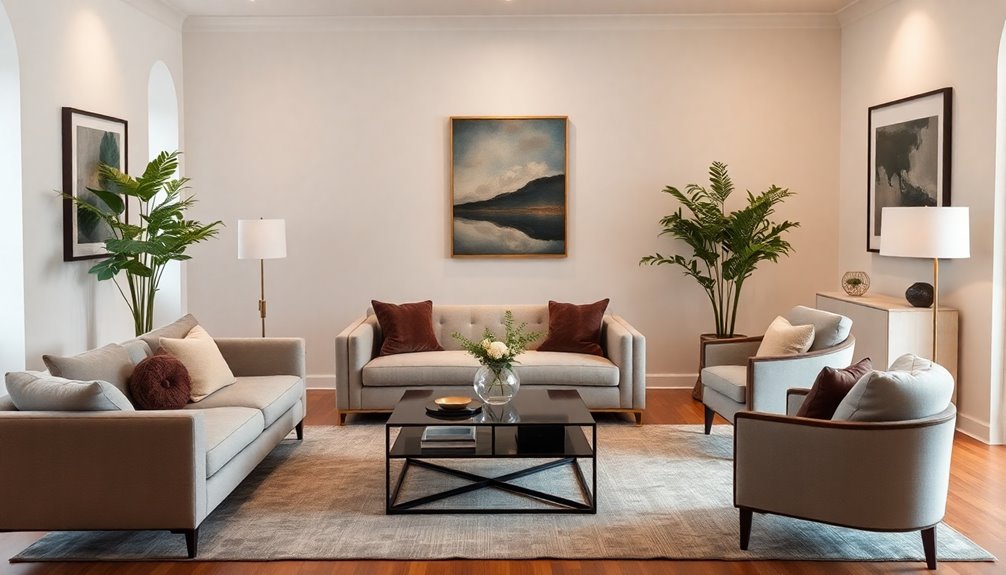
After experimenting with various layouts, you might find that achieving your ideal design requires more than just personal effort. Hiring a professional designer can bring your vision to life in ways you might not have considered. They ensure a cohesive and purposeful design that genuinely reflects your style while working within your budget.
Professional designers have access to an extensive network of trusted contractors, suppliers, and artisans, which streamlines the design process. They manage every detail, from creating a solid plan to sourcing materials, saving you time and stress. Their services typically include design consultations, site measurements, and the creation of personalized design concepts. Additionally, their expert guidance can help you navigate design choices that may seem overwhelming, as they often possess emotional intelligence that enhances team collaboration and project execution.
To find a designer, consider platforms like Upwork and Decorilla, where you can connect with skilled professionals based on your preferences. Houzz allows you to filter designers by location, budget, and style, ensuring you find the right fit. Local firms, such as apartmentjeanie, specialize in space planning and can offer tailored solutions.
Working with a designer involves an initial consultation to understand your needs, followed by in-depth assessments. They'll provide proposals and collaborate with you throughout the process, ensuring your space reflects your unique taste.
Frequently Asked Questions
How Can I Incorporate My Personal Style Into Furniture Arrangement?
To incorporate your personal style into furniture arrangement, start by identifying your favorite colors and design elements. Use a mood board to guide your choices, ensuring each piece reflects your taste. Group furniture in a way that highlights your unique style, whether it's modern, bohemian, or eclectic. Don't forget to add personal touches like artwork or family photos, as these elements bring warmth and character, making the space truly yours.
What Colors Should I Consider for a Harmonious Room Design?
For a harmonious room design, consider an analogous color scheme by choosing colors next to each other on the color wheel, like greens and blues. Stick to 3 to 5 colors to keep things interesting, and think about the vibe you want—cool, warm, or neutral. Use the 60-30-10 rule for balance, and let existing elements like furniture inspire your palette. Testing colors in different lighting can help ensure they work well together.
How Do I Choose Furniture That Fits My Lifestyle?
When choosing furniture that fits your lifestyle, think about your daily activities and how the space will be used. If you have kids or pets, opt for durable fabrics that can withstand wear and tear. Consider multifunctional pieces, like a coffee table with storage, to maximize space. Always test for comfort and support before purchasing, ensuring your selections meet both aesthetic and practical needs, creating a cozy and functional environment.
What Are the Best Materials for Durable Furniture?
When you're looking for durable furniture materials, consider options like teak and IPE, known for their long-lasting properties and resistance to weathering. Acacia and oak also offer strength and beauty. For outdoor pieces, aluminum and stainless steel are lightweight yet sturdy choices. If you prefer synthetic options, HDPE lumber and synthetic resin provide excellent durability and weather resistance. Each material has unique benefits, so think about your specific needs and preferences before deciding.
How Can I Maximize Natural Light in My Room Layout?
To maximize natural light in your room layout, start by positioning your furniture away from windows. Opt for shorter pieces to keep sightlines clear. Use light-colored and reflective materials, like glass and mirrors, to bounce sunlight around. Incorporate sheer window treatments to filter light without blocking it. Lastly, place your brightest, most active spaces near south-facing windows to take advantage of the sunlight throughout the day.
Conclusion
Arranging furniture can transform your space into a functional and inviting environment. By taking measurements, choosing a focal point, and ensuring smooth traffic flow, you'll create a comfortable atmosphere. Remember to set up conversation areas and maintain visual balance for a cohesive look. Don't hesitate to experiment with different layouts until you find what works best for you. If you're feeling overwhelmed, seeking professional help can provide valuable insights. Enjoy the process and make your space truly yours!
